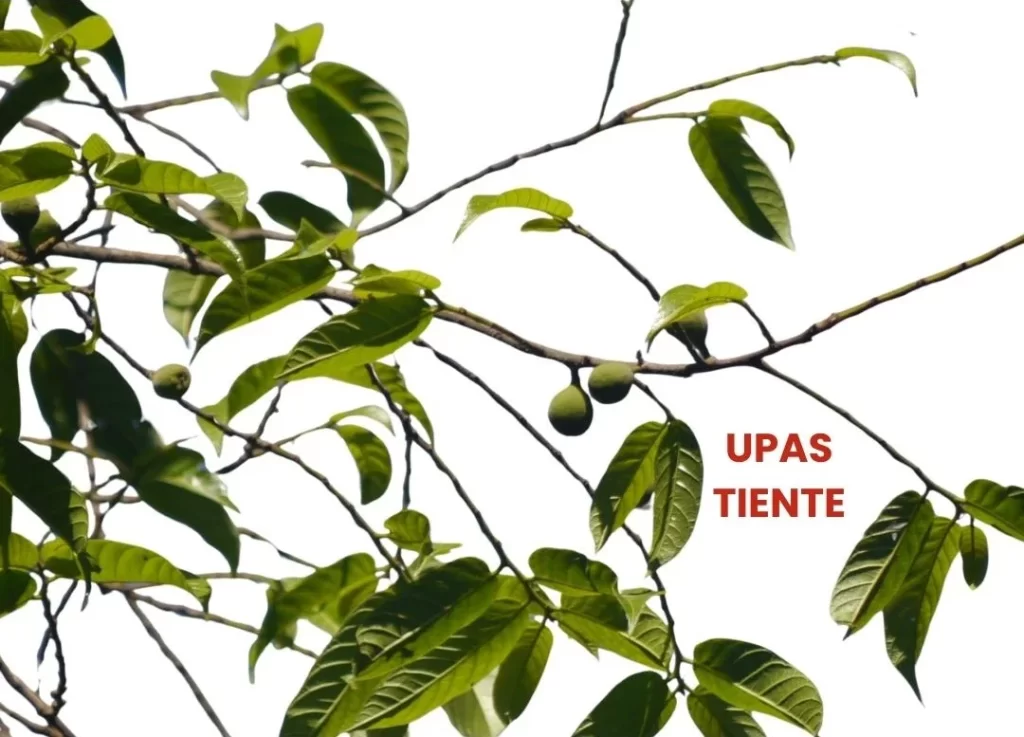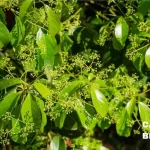Upas Tiente, derived from the Upas tree (Strychnos Tiente), is a homeopathic remedy known for its ability to induce tonic spasms, tetanus, and asphyxia.
It affects various systems of the body, including the nervous, respiratory, and reproductive systems, leading to specific symptoms that guide its therapeutic use.

Table of Contents
ToggleSOURCE INFORMATION
Scientific Classification
- Kingdom: Plantae
- Order: Gentianales
- Family: Loganiaceae
- Genus: Strychnos
- Species: Strychnos Tiente
Origin
- The Upas tree, native to Southeast Asia, particularly Java, Indonesia, is infamous for its toxicity.
- It produces a resinous exudation that contains strychnine, a potent poison.
Historical Facts
- In traditional medicine and folklore, the Upas tree was feared and revered for its deadly properties.
- It was used as an arrow poison by indigenous tribes in Java and has been the subject of numerous legends and stories.
DRUG PATHOGENESIS
- Upas Tiente primarily affects the nervous system, leading to tonic spasms, tetanus-like symptoms, and respiratory distress.
- It induces irritability, dull headaches, and disinclination for mental work.
KEY CHARACTERISTIC
- Induces tonic spasms, tetanus, and asphyxia.
- Irritability, disinclination for mental work, and dull headaches.
- Eye symptoms include pain, conjunctivitis, and sunken appearance.
- Mouth symptoms involve herpes, burning, and sensation of pain.
- Male reproductive symptoms include increased desire with loss of power.
- Chest symptoms include lancinating pain and palpitations.
- Skin symptoms include numbness, inflammation, itching, and redness.
PARTICULAR ORGAN SYMPTOMS
HEAD
- Disinclination for mental work: Individuals may feel a reluctance or aversion to engaging in mental tasks or activities requiring concentration.
- Irritability: There is a tendency towards being easily annoyed or provoked, often accompanied by a heightened emotional sensitivity.
- Dull headache: A persistent, mild to moderate headache characterized by a sensation of heaviness or pressure deep within the brain.
EYES
- Pain in eyes and orbits: Individuals experience discomfort or aching sensations in the eyes or the bony sockets surrounding them.
- Conjunctivitis: Inflammation of the conjunctiva, the thin membrane covering the white part of the eye and the inner surface of the eyelids, leading to redness, irritation, and discharge.
- Sunken appearance: The eyes may appear hollow or deeply set, giving a sunken or recessed appearance.
- Styes: Painful, inflamed bumps or pimples near the edge of the eyelid, typically caused by bacterial infection of the oil glands in the eyelid.
MOUTH
- Herpes on lips: Presence of cold sores or blisters on the lips caused by the herpes simplex virus.
- Burning tongue: Sensation of heat, discomfort, or pain affecting the tongue, often accompanied by redness or inflammation.
- Sensation of pain: Individuals may experience various types of discomfort or pain sensations in the mouth, resembling the feeling of having a splinter or foreign object lodged in the oral cavity.
MALE
- Increased desire with loss of power: Heightened sexual desire or libido accompanied by a decrease in sexual potency or ability to achieve and maintain an erection.
- Dull backache: Persistent, mild to moderate pain in the lower back, often described as a dull, achy sensation, typically occurring after prolonged or excessive sexual activity.
CHEST
- Lancinating pain: Sharp, stabbing pains, often sudden and severe, felt throughout the right lung region, extending towards the liver, and causing breathing difficulties.
- Palpitations: Sensation of rapid, irregular, or pounding heartbeat, sometimes accompanied by a feeling of fluttering or “butterflies” in the chest.
- Heaviness in stomach: A sensation of weight, fullness, or discomfort in the upper abdomen, often accompanied by bloating or indigestion.
SKIN
- Numbness: Partial or complete loss of sensation in the hands and feet, often described as a tingling or “pins and needles” sensation.
- Inflamed hangnails: Painful, swollen, or infected skin around the base of the nails, typically caused by irritation or injury.
- Itching: Unpleasant, tingling, or prickling sensation on the skin’s surface, often leading to an irresistible urge to scratch.
- Redness at nail roots: Presence of redness or inflammation at the base of the nails, indicating localized irritation or infection.
MODALITIES
- Symptoms worsen with increased irritability, mental exertion, and physical strain.
- Symptoms may improve with rest and relaxation.
RELATIONSHIP WITH OTHER DRUGS
- Similar to Upas Antiaris in producing tonic spasms and respiratory distress but differs in the pattern of spasms and accompanying symptoms.
- Antidote: Curare.
DOSE
- Administer Upas Tiente in third to sixth potency, preferably in dry form.
Frequently Asked Questions
Q: What are the primary effects of Upas Tiente on the body?
A: Upas Tiente induces tonic spasms, tetanus-like symptoms, and respiratory distress, primarily affecting the nervous and respiratory systems.
Q: How should Upas Tiente be administered?
A: It is typically administered in third to sixth potency, preferably in dry form.
Q: Are there any specific symptoms that indicate the need for Upas Tiente?
A: Symptoms such as irritability, disinclination for mental work, dull headaches, and respiratory distress may indicate the need for Upas Tiente.
Q: Is Upas Tiente safe for self-administration?
A: Upas Tiente should be used under the guidance of a qualified homeopathic practitioner, especially due to its toxic nature and potential for adverse effects.
Q: Can Upas Tiente be used alongside conventional medication?
A: It is advisable to consult a healthcare professional before using Upas Tiente alongside conventional medication, as it may interact with certain drugs.
Meaning of Difficult Words
- Tonic spasms: Involuntary muscle contractions characterized by stiffness and rigidity.
- Tetanus: A serious bacterial infection that causes painful muscle stiffness, often leading to lockjaw and respiratory distress.
- Asphyxia: A condition characterized by the deprivation of oxygen, resulting in suffocation or unconsciousness.
- Conjunctivitis: Inflammation or infection of the transparent membrane (conjunctiva) covering the white part of the eye and inner surface of the eyelids, commonly known as pink eye.
- Herpes: A viral infection causing painful sores, usually around the mouth or genital area.
- Lancinating: Describing a sudden, sharp, stabbing pain.
- Palpitations: Abnormal awareness of the heartbeat, often described as a pounding, fluttering, or racing sensation in the chest.
- Numbness: Lack of sensation or feeling in a part of the body.
- Inflamed: Red, swollen, and often painful due to inflammation or irritation.
- Hangnails: Small, torn pieces of skin at the edge of a fingernail or toenail.
- Modalities: Factors or conditions that affect the symptoms of a disease or condition, such as aggravating or ameliorating factors.
- Antidote: A substance that counteracts the effects of poison or toxins, providing relief or reversing their effects.













Leave a Reply